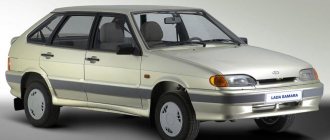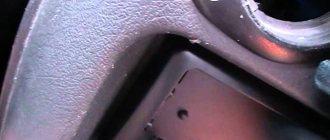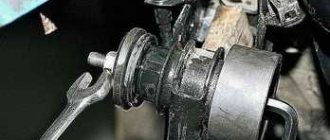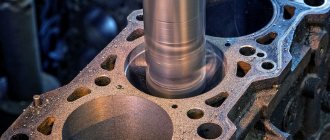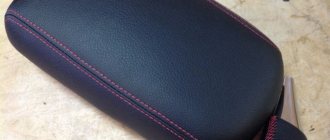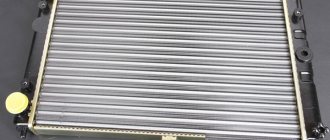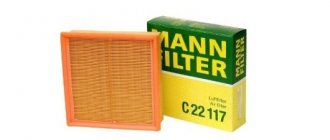There are many ways to update the boring interior design of your car. You can reupholster the interior and seats, add some additional options and bells and whistles. And if you want to change something on the VAZ 2110, then the best option is to put dozens of elements from the Lada Priora into the interior. The convenience lies in the fact that almost all elements of the Priora (seats, panels, plastic) fit perfectly into the top ten. Having installed some parts of the interior from other cars (for example, from a foreign car), you will have to cut, sharpen, adjust and tear out something. And most of the interior elements of the Priors fit the VAZ 2110 without any problems.
Torpedo from Priora on VAZ 2110
There are many ways to update the boring interior design of your car. You can reupholster the interior and seats, add some additional options and bells and whistles. And if you want to change something on the VAZ 2110, then the best option is to put dozens of elements from the Lada Priora into the interior. The convenience lies in the fact that almost all elements of the Priora (seats, panels, plastic) fit perfectly into the top ten. Having installed some parts of the interior from other cars (for example, from a foreign car), you will have to cut, sharpen, adjust and tear out something. And most of the interior elements of the Priors fit the VAZ 2110 without any problems.
If disassembly is needed
Let us immediately note that if you have to replace the lining with a new one (the one you choose), then a complete disassembly may not be necessary for this.
1. The pad itself
2. Inserts for buttons, air ducts, instrument panel trim
But if noise insulation is planned due to the fact that the dashboard rattles when driving, then this cannot be avoided.
Disassembly work requires a lot of time and special scrupulousness. After all, if some fastening is spoiled or broken, then the new or tuned torpedo will not work as it should, it will creak and rattle unhappily while driving, spoiling the mood of the careless disassembler.
We install a new panel on a VAZ 2110
An important part of the car interior is the panel. The torpedo from the VAZ 2110 is morally outdated, although of course most drivers are still happy with it. Installing a torpedo from a Lada Priora to a ten is a troublesome task, but it’s worth it. The VAZ 21104 panel is more modern and convenient, although the quality of the plastic leaves much to be desired. The exception is wiring. You'll have to tinker with it a little longer. But we'll talk about this later.
Removing a panel from tens turns out to be not an easy task. And you can’t just pull one out and put the other in. But it’s quite possible to remove the old panel yourself. To do this, you will need several types of screwdrivers (two Phillips with a long and short blade and one simple), a 10mm deep socket, wire cutters, and a flashlight.
When starting removal, the first thing you need to do is disconnect the negative terminal from the battery. For additional convenience, you can remove the two front wheels, this will provide additional space for such labor-intensive work.
We immediately take out the simplest elements from the VAZ 2110 dashboard, such as: the standard clock, the heater control unit, the display unit, as well as the central deflector and radio. Then we unscrew the screws located on the sides that hold the tunnel. Remove the housing from the gearshift lever and take it out. Next we dismantle the steering wheel casing and steering wheel. To do this, unscrew the self-tapping screws and fixing screws.
The steering wheel usually fits very tightly, so to remove it you need to rock it from side to side. Remove the switches located under the steering wheel. Next comes the glove compartment. We remove the fasteners and remove it from the seat. Then we dismantle the mounting block. You need to pull out and disconnect all relays and connectors. Remove the panel and rack covers. It is very important at this stage to release the fasteners of the hydraulic headlight range control. We remove the torpedo. You need to unscrew the screws and studs holding it. Then we free the panel from the steering shaft and air duct. We pull it towards ourselves and the job is done. Assembly is carried out in reverse order.
When purchasing a new panel, you need to take into account that part of the wiring is included with the torpedo. Here you can partially save on wiring. You will also need noise insulation and panel mounting in the area of the electronic control unit. This will be required so that the torpedo from Priora fits tightly onto the VAZ 2110 without any complaints. The entire standard panel from Priora fits into the top ten without any problems, all fastenings and seats fit. You can also install a euro torpedo on the VAZ 2110. There are no comrades here for taste and color. It also looks modern and respectable. It will be very interesting for friends and acquaintances to see this innovation. The price of panels ranges from 5 to 8 thousand rubles.
Dismantling algorithm
- We remove and remove the front seats from the interior so that they do not interfere with the disassembly;
- Disconnect power from the battery;
- We lower the steering wheel of the VAZ 2110 to the lower position;
- Unscrew the screws that secure the panel covers. These are two screws on both sides of the tunnel. Now you can remove the shield;
- We remove the plug on the tunnel in the center by prying it off with a screwdriver;
- We unscrew the screws of the central tunnel to remove it. Before doing this, disconnect the wires from the cigarette lighter;
- We remove the air duct for heating the interior of the VAZ 2110. To do this, having disconnected the cover from the gearbox, you need to pry off the latches with a screwdriver, then remove the air duct;
- We remove the central panel by unscrewing it from the floor;
- Now it is possible to disassemble the torpedo. First, unscrew the mount that holds the glove compartment, disconnect it from the backlight, and take it out;
- In the hole where the glove compartment was located, we remove the screws on both sides, as well as directly behind the glove compartment;
- We unscrew the VAZ 2110 torpedo mount with a key and a screwdriver;
- Near the left pillar we pull out the air duct by prying it with a screwdriver;
- With special care you need to remove the torpedo, supporting it with your hands while unscrewing the nut with a spanner. Then, lifting it up, remove it from the pins;
- Now you need to remove all the wires, marking them with a marker as you go so that you don’t get confused when reinstalling them;
- It became possible to replace the lining and carry out noise insulation work.
Wiring from Lada Priora to VAZ 2110
The wiring has the most problems.
The fact is that the wiring of the priors is different from the wiring of the tens. And before you start connecting, you need to carefully study the instructions for the electrical part of both machines. Connectors and chips from cars do not fit each other. Therefore, there are two options for the development of events. On the top ten, you can install all the wiring from the VAZ 21104, located under the hood and in the cabin. But you can go the other way, try connecting the wiring of both machines. In this case, you will need to replace and resolder all connectors. You will also have to replace the mounting block, and you may have to install an electric drive in the stove.
The Lada Priora control unit (2110-3763040), which is responsible for the entire electrical component of the car, can of course be set to ten, but it is not economically profitable. That's why they usually don't install it. The price of such a block is 2500-4000 rubles. The cost of wiring is 1300-1700 rubles. You can buy it cheaper somewhere at a salvage yard.
Required
The updated dashboard with navigation is called “Itelma” and can be of two types (externally no different):
- 2170-3801010-50 without CAN bus (installed on Prioras until approximately 06.2012);
- 2170-3801010-60 with CAN bus (installed from 06.2012).
For the “ten” and Kalina (VAZ 1117, 1118, 1119) only the first option is suitable. Thus, to install a restyled instrument panel from Priora you will need:
- Instrument panel 2170-3801010-50 without CAN bus
- Right steering column switch with joystick (catalog number: 1118-3709340-20), left - 21230-3709330-00
- GPS antenna for navigation, which is installed on the roof (article 1118-7903074).
You can buy in parts or as a set (tidy + antenna + switch): 2170-3801010-55 or 1118-3801010-55.
Car differences
Lada Priora and VAZ 2110 are of course identical cars, but they also have differences.
Car enthusiasts often find it difficult to decide which model to give preference to. But in any case, the Priora is a more modern car. Thus, the electric power steering gives greater comfort when driving a Lada Priora than driving a ten. In dozens, power steering was introduced only in 2006, and the VAZ-21104 immediately came from the factory with an electric power steering wheel. If someone comes across a ten with electric power steering, then know that it was installed by someone in a car service center. A feature of the Priora steering is a large amount of play in the steering wheel, which takes some getting used to. At high speed, you have to “catch the car on the road,” as it were. Therefore, many drivers at the time gave preference to the VAZ 2110, which behaves more confidently at speed. But still, when cornering and when driving in a zigzag manner, the VAZ 21104’s movement is more comfortable and confident than that of its predecessor. The Priora behaves more dynamically at speed if an appropriate brace is installed between the supports of the front struts. In this case, drivers note improved handling.
The engines of both cars are reliable and simple. The Priora's engine has superior technical characteristics, but the eight and sixteen valve units do not differ much in the traction properties of both cars. Some will say one or the other is better, but in general we can say that they are all the same.
There is a little less transmission noise in the Prior and the cabin is probably a little quieter. But most likely this is due to the fact that the developers did a good job on sound insulation in the VAZ-21104.
And yet, driving in a Prior is quieter and more comfortable. The size of the car interiors is absolutely the same. The seats and all the plastics fit from one car to another. True, the seats on the Prior are a little higher. This fact will please small drivers and disappoint giants.
Priora at one time enjoyed enormous success in the post-Soviet space. In the Caucasian republics it was the best-selling car. In general, it is impossible to say with certainty which car is better and which is worse. Each person makes his own choice based on personal experience.
Comparison of Lada 110 and Lada 2170 Priora
VAZ 2110 and Lada Priora. They are so different, but at the same time so similar. Heredity is very clear. In addition to many technical differences and the time spent on the assembly line, these 2 models also have differences in quality and controllability, at least that’s what AvtoVAZ thinks. This is exactly what we will try to find out. For clarity, we have the Lada 110 and its successor, the Lada Priora, standing side by side, which has a factory index of 2170. It is also sold under this name in other markets. So, let's go.
from VAZ 2110 to VAZ-217220 (Priora)
- experienced forum member
- Group: Users
- Messages: 1,797
- forum member
- Group: Users
- Posts: 115
- repair of movable property
- Group: Users
- Posts: 518
- Megatheronosaurus
- Group: Users
- Posts: 14,452
- Pachimushta Zhrukhot!
- Group: Users
- Posts: 4,591
Post edited by Zerg: 02/09/2013 – 19:07
- experienced forum member
- Group: Users
- Posts: 2,357
Zerg (02/09/2013 – 19:04) wrote:
- forum member
- Group: Users
- Posts: 115
Post edited by Marty McFly: 02/09/2013 – 19:47
- Chip-Tuning
- Group: Users
- Posts: 1,787
- forum member
- Group: Users
- Posts: 115
fastrex (02/09/2013 – 21:16) wrote:
Post edited by Marty McFly: 02/09/2013 – 21:25
- experienced forum member
- Group: Users
- Posts: 2,478
Post edited by DenisCHCH: 02/09/2013 – 21:40
- experienced forum member
- Group: Users
- Posts: 2,478
better sell your unfortunate ten, buy a short-winged eight, wash down the roof and style it ala DeLorean - this will be a “PROJECT” worthy of respect.
And if you still decide to go for a ten-wheel drive, there is a front prior bumper, complete for painting, 600 RUR
Post edited by DenisCHCH: 02/09/2013 – 21:44
- Chip-Tuning
- Group: Users
- Posts: 1,787
DenisCHCHCH (02/09/2013 – 21:41) wrote:
better sell your unfortunate ten, buy a short-winged eight, wash down the roof and style it ala DeLorean - this will be a “PROJECT” worthy of respect.
And if you still decide to go for a ten-wheel drive, there is a front prioro bumper, complete for painting, 600 rubles. Post edited by DenisCHCH: Today, 21:44
Why are you pushing a man to cramp, he wants style.
- Megatheronosaurus
- Group: Users
- Posts: 5,388
fastrex (02/09/2013 – 21:50) wrote:
- Chip-Tuning
- Group: Users
- Posts: 1,787
- forum member
- Group: Users
- Posts: 115
DenisCHCHCH (02/09/2013 – 21:30) wrote:
Yes, it’s not pissed here yet) shitting means we’ll be here
Professor_ (02/09/2013 – 21:54) wrote:
fastrex (02/09/2013 – 21:50) wrote:
it will look normal and it will all cost a penny and it will be nice and cheap
VAZ-2110-Priora
Previous generations:
No
| VAZ-2110-Priora | |
| Specifications: | |
| body | Four-door sedan |
| Number of doors | 4 |
| number of seats | 5 |
| length | 4350 mm |
| width | 1680 mm |
| height | 1420 mm |
| wheelbase | 2492 mm |
| front track | 1410 mm |
| rear track | 1380 mm |
| ground clearance | 170 mm |
| trunk volume | 430 l |
| engine location | front transverse |
| engine's type | 4-cylinder, petrol, injection, four-stroke |
| engine capacity | 1597 cm 3 |
| Power | 98/5600 hp at rpm |
| Torque | 145/4000 N*m at rpm |
| Valves per cylinder | 4 |
| KP | five-speed manual |
| Front suspension | independent |
| Rear suspension | semi-dependent |
| Shock absorbers | hydraulic, double acting |
| Front brakes | disc, ventilated |
| Rear brakes | drums |
| Fuel consumption | 7.2 l/100 km |
| maximum speed | 183 km/h |
| years of production | 2006-present |
| type of drive | front |
| Curb weight | 1095 kg |
| acceleration 0-100 km/h | 11.5 sec |
The main premiere of 2006 can be called the beginning of mass production of the first child of the new LADA PRIORA sedan family. The plant first introduced the public to this car in 2003, when it presented an experimental sedan called “Project-2170” at the Moscow International Auto Show. A year later, a hatchback from the same family was shown in the capital, which by that time had received the designation PRIORA. In mid-summer 2006, the main stage of preparation for the production of new cars was completed, and at the end of the year the first cars arrived at dealers. In 2008–2009 LADA PRIORA should completely displace the outdated LADA 110 family from the production program. Constructors and designers expect that a thorough redesign of the platform and body will be positively received by customers, and the inevitable increase in price will occur within reasonable limits. In a significant design change that certainly makes the PRIORA cars more attractive, the fit of the body panels has been improved and the gaps between them have been kept to a minimum. High quality body assembly is ensured through the use of modern electronic methods for designing and manufacturing dies using mathematical models. Japanese companies helped solve this problem. LADA PRIORA with a sedan body has an aerodynamic drag coefficient of 0.32, which is one of the best indicators among analogues. Modern lighting technology, the absence of plastic parts, side pillars with special moldings that catch water when the windshield wipers operate - all this distinguishes the new product from the representatives of the previous family. Italian specialists took part in the development of the original interior together with factory designers. As a result of the joint work of specialists, the following appeared: new instrument cluster, steering column switches, steering shaft housing, gear lever, door and ceiling trim, four-spoke steering wheel with an airbag module, etc. New interior elements include a small box with a central armrest on the floor tunnel with space for a phone and a socket for connecting it. An eyeglass case is placed on the ceiling along with the individual lighting lamp. Much attention was paid to improving the parameters of the air environment in the cabin. Athermal glass is installed on all manufactured cars. A new climate system with electronic control and air recirculation has been developed for the PRIORA family. The new heater for the “norm” and “standard” configuration options is complemented by a built-in air purification filter. Luxury options are equipped with a heater and air conditioner in a single unit. The sound insulation of the cabin has been significantly improved, the squeaks of plastic parts have been completely eliminated, and in order to reduce air noise, a noise-absorbing element has been installed at the inlet of the air filter. The cars of the PRIORA family are equipped with a modernized 16-valve engine with a displacement of 1.6 liters. Changing the crank mechanism with a shortened piston made it possible to reduce the mechanical losses of the VAZ-21124 engine and increase power to 98 hp. With. at 5800 rpm and torque up to 145 N•m at 3600 rpm. A new control system with a Bosch M7.9.7 controller guarantees reliable engine starting at low temperatures, while the engine is available in versions that meet the requirements of Euro-3 and Euro-4 standards. The new engine has improved the dynamic properties of the cars, while maintaining their high efficiency, especially when driving at high speeds. An increase in acceleration dynamics and maximum speed dictated changes in the chassis. Tires of size 18560R14 appeared on the cars, the installation of which had a positive effect on increasing the lateral stability and resistance of the car to drift. The “norm” and “standard” options are equipped with wheels measuring 5.SJx14 with a reinforced lip, while the “luxury” options are equipped with alloy wheels of the same size. Increasing the overall rigidity of the body had a positive effect on the stability of the kinematic parameters of the electric power steering and improved the stability and controllability of the vehicles. The newly redesigned body shells of the PRIORA family contain 12 base reinforcements, allowing the vehicle to confidently meet the latest EuroNCAP passive safety requirements. In order to increase the level of passive safety, the following were introduced: a soft pad on the instrument panel to prevent injury to the front passenger, an airbag for the front passenger installed on luxury versions, an energy-intensive beam that protects the driver’s legs, and three-point seat belts for those sitting in the rear seat. The bodies of cars of the PRIORA family compare favorably with the bodies of the LADA-110 family with increased corrosion resistance. The share of galvanized steel in them from the total mass of the body is 52% or 29% of the total surface area of the body. Wheel arches, sills, floor parts are made of galvanized steel with double-sided coating. For hinged body panels (fenders, hood, trunk lid), steel with one-sided zinc coating is used. Anti-corrosion treatment of bodies includes applying a two-component primer to the welded body, 100% protection of welds. LADA PRIORA cars are equipped with reliable electronic equipment with advanced switching. Blocks with increased tightness were used, additional fuses for power circuits were introduced, and for the first time, a multiplex system was used on AVTOVAZ products, which reduced the number of electrical wires in car doors.
Heir to the “ten”: how the Lada Priora was created
At the end of the difficult nineties, when the VAZ-2110 in the eyes of the potential audience was still a new model and was just reaching its designed production capacity, VAZ had long understood that the car, which they began to create back in the eighties, required, if not a radical replacement , then at least a cosmetic update.
Greeted by clothes
World experience has suggested that, first of all, modernization requires the appearance, which for the “ten” turned out to be very peculiar for a number of reasons. Thus, the designers were faced with a difficult task: it was necessary not only to “refresh” the car, but also to rid it of the heaviness characteristic of the “pregnant antelope” of the tenth model.
It became obvious that not only the typical replacement of bumpers or some kind of lining would be required, but also a complete rework of the front and rear parts. After all, in order to radically change the optics, you will have to change the hood, which on the “ten” extends over the front wings. And the rear bumper, which connects vertically with the rear fender, visually made the car look heavier. And finally, the rear wheel arches required revision, because of which the car looked, as they say, weak-willed.
The designers did not immediately come to a final decision - the appearance of the serial Priora was preceded by five previous, in its own way, search options. Initially, VAZ tried to solve the issue with “little loss” - using optics from the VAZ-2123 (Chevrolet Niva) and minimal modifications to the hardware. Due to technological limitations, during modernization it was impossible to change the stamps of the roof, doors and sidewalls, which, however, is rarely done during a classic facelift.
For quite a long time, designers had to look for the shape of the rear part. And they found her! The general style of the stern is reminiscent of some European cars of the late nineties (for example, Opel Vectra B). The final appearance was formed at the beginning of 2001 - in fact, it was at that time that the “ten” required a cosmetic rewrite.
Pre-production sedan VAZ-2170
It was understood that the update would affect not only the sedan, but also the 2112 hatchback, as well as the 2111 station wagon. After the sedan, the production of the five-door with the index 2172 began, and then the station wagon 2171
In this form, Priora appeared before the public in 2003
The interior was not easy for the designers either. Given strict restrictions (for example, the seats could not be touched), VAZ made its own, quite interesting version called Status (it can be seen on prototypes), but. then the development was ordered to the Italian engineering company Carcerano Creative Engineering, at that time recently (in 1999) founded in Turin by Pier Luigi Carcerano.
VAZ version of the Status interior
True, the company was not so much a design studio as an engineering enterprise, and in fact, with the design of interior options from the Italians, everything did not work out quite smoothly at first. Tolyatti designers had to go to Italy and, figuratively speaking, “adjust with a file” the European creation to the level of the VAZ school. And this is without irony: after all, by that time VAZ designers had extensive experience in designing car interiors and its practical implementation at the level of launching into production.
It is interesting that the designers practically did not work with soft material, limiting themselves to milling a cube made according to a mathematical model. Nevertheless, objectively, the design of the interior parts (especially the dashboard!) of the Priora should be recognized as the best of the VAZ cars of the period before the tenth years of this century.
Priora has a completely “foreign” interior. It looks, for example, like the interior of a Chevrolet Lacetti
Not just cosmetics
In addition to changes visible to the naked eye, in the process of transforming from a “ten” to a Priora, the car has noticeably changed at the level of technology. There are fewer deviations in body panels; stamps, joints, and welding are made more accurately. This was facilitated by the purchase of certain equipment (in particular, face stamps) in Japan.
In terms of the number of original parts, the Priora differs from the VAZ-2110 almost as much (!) as, for example, Kalina! Yes, despite the external similarity and the similar basis of the frame, the car was subjected to a serious modernization during the renovation process - the old technologies did not want to fit in with the new level at which they wanted to make a model in Tolyatti!
And although the layout and platform of the Priora have not fundamentally changed compared to previous front-wheel drive vehicles, on the “seventy” it was thoroughly “shoveled”, eliminating many of the shortcomings inherent in the “ten” chassis. The suspensions received new parts and characteristics of elastic elements, the steering was equipped with an electric booster, and the brakes became more efficient and lighter. Even the 16-valve engine, which at one time seemed like the ultimate dream and the height of perfection, received pistons with a shortened skirt and a new crank mechanism. We don’t need to tell anyone that the engine with index 21126 ended up being very peppy, but at the same time economical and environmentally friendly.
Moreover, Priora became the first VAZ model modified to meet EuroNCAP requirements and received airbags and belt pretensioners as factory equipment! Also, for the first time, VAZ used partial multiplex wiring - the so-called CAN bus. No matter what evil tongues may say, the VAZ team managed to quite successfully modernize their problem child of the tenth model, bringing it closer in terms of technology to modern developments of that time. After all, Priora, from the point of view of progressiveness of design, was in no way inferior to, for example, the same Logan and at the same time noticeably superior to Nexia and Lanos.
Priora was even supplied to Germany
Priora's optics were also designed at a fundamentally different level. Modern, beautiful, efficient head optics are exactly what the “blind” Samara-2 and cars of the tenth family lacked.
The first production cars had 2110 wheels
And the equipment could be unprecedentedly luxurious by the standards of former VAZs. Full power accessories, heated seats, air conditioning, electric power steering and even ABS - Priora was originally conceived as a competitor to foreign-made cars, not only in terms of price, but also in terms of comfort! At the same time, the equipment was not just nominally present in its place, but also functioned quite normally.
The silhouette of the Priora turned out to be quite dynamic: it is practically devoid of “tens” heaviness
Long-lived
A prototype of the future Priora was ready in 2003. However, the VAZ-2170 installation series was released only in 2006. From the beginning of 2007, the number of Priors produced began to be measured in the hundreds, and by the end of the year the plant reached a volume of 6,000 cars per month. Already at the beginning of 2009, the Priora completely replaced the “ten” on the assembly line, becoming at that time the most powerful and well-equipped VAZ car. A nice-looking car with a fairly dynamic engine and quite well-stuffed with options, it quickly found its buyer and is still in production, becoming a real long-liver by the standards of the modern automobile industry.
Did you like the article? Subscribe to the channel to stay up to date with the most interesting materials
Vibrant variety of colors
Today, the fashion for changing the dashboard lighting is gaining fantastic momentum. Almost everywhere cars have neon lighting or internal LED illumination. However, all these innovations are not a cheap pleasure, which not everyone can afford. The situation is different when replacing the factory backlight with a multi-colored one.
You can, no doubt, use ready-made tuning options, but this will also cost a lot. It is best to do it yourself. In this situation, the main thing is to have the necessary materials and patience. First you have to disassemble the “tidy”. The protective glass must be removed. Next we remove the arrows. To do this, you need to use a screwdriver and hard cardboard.
It should be placed under the arrow, and then pry it off with a screwdriver. Then you need to carefully and slowly lift it to the top. Next, remove the backing. A utility knife will be useful for this. It must be inserted between the panel and the substrate and a layer of sealant must be cut in a circle. Then remove the backing. Let's disassemble the panel and get started.
1. Remove the filter layer using a utility knife. A filter is a colored layer of paint. It is applied from the back of the substrate and gives color illumination to the speedometer numbers and other sensors. To completely get rid of the filter, you can use acetone or another liquid that contains alcohol.
2. Next, change the backlight color. First, you can change the odometer backlight. To do this, you will need to dismantle the odometer screen, and then remove the blue film and remove the backlight bulb. It should be replaced with a multi-color universal LED. He can change colors. We connect the LED to the socket of a standard light bulb. Reinstall the odometer screen.
3. Now you can start completely replacing the backlight. We attach the LEDs to the “tidy” frame. Such LEDs can be purchased complete with a color switch. We install them in place and attach them to the standard dashboard backlight contacts.
4. Let's move on. Now we need to make sure that the arrows have the ability to change the backlight. To do this, remove the layer of red paint from the arrows. For this operation, you can use a stationery knife and acetone. Once the arrow is clean, it can be painted using white nail polish. The main thing is that the arrow is white, since this color conveys the color scheme of the LEDs.
5. Before the final stage, you need to attach the LED color switch to the panel. Such a switch can be installed, for example, in the lower right corner of the dashboard. After this, you can install everything in place. First, the substrate is installed. For greater reliability, you can use a sealant. After this, we put the arrows in place. We insert the protective glass. After that we admire the result.
